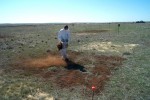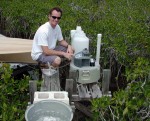"Decomposition of Cladium jamaicense and Eleocharis spp. in the ecotone regions of Taylor Slough and Shark River Slough"
by Gustavo Rubio, Department of Biology, Florida International University
A project that combines science and technology can obtain superior results than one that just includes one or the other. This project is set to mix science and technology to measure the ecosystem process of decomposition for two predominant macrophyte species Cladium jamaicense and Eleocharis spp.. The project is to take place in the ecotone regions of Shark River Slough and Taylor Slough located in the Everglades National Park (ENP). The ecotone regions of both sloughs experience a mixing between fresh water and salt water that makes them unique from all the other regions found in the sloughs.
Decomposition rates for Cladium jamaicense and Eleocharis spp. will be measured by using litter bags which contains dead plant material for both species. Litter bags will experience three different treatments
- Open air to account for decomposition of leaves before they are shed by the plant
- Soil surface to account for decomposition once the leaves have been shed by the plant and reach the soil surface
- Macroinvertebrates in which the mesh size of the litter bags will be bigger to allow macroinvertebrates in the bags. Three bags from each treatment will be collected after 0, 1, 2, 4, 6, 12, and 18 months
- Two scenes from NASA Airborne Visible InfraRed Imaging Spectrometer (AVIRIS) hyperspectral sensor will be used to measure nitrogen and lignin content, which are important components that determine leaf litter decomposition, in dead Cladium jamaicense leaves for both ecotone regions. The results of this project will be useful for management and restoration project that are being done in the ENP
"Investigating tree island community response to increased water flow in a Southeastern Everglades ecosystem"
by Tiffany Gann, Department of Biology, Florida International University
Tree island communities have a distinct flora and are likely to be functionally different from the Everglades marsh community. This experiment takes advantage of levee removal in the southern Everglades as a part of the hydrologic restoration of freshwater flow to Florida Bay.
We are utilizing three treatment groups:
- Islands that are most affected by increased water flow as a result of levee removal
- Islands that are located in an area of the marsh where increased freshwater flow is negligible
- In experimental manipulation in which freshwater flow is diverted with plastic walls. With this experimental design, we will test how tree island communities respond to long-term changes in water flow, and also determine the trajectory for tree island community response.
To investigate these effects, we are quantifying plant community structure, plant productivity, litterfall production, nutrient use efficiency, litter decomposition and soil biogeochemical properties of nine tree island communities.
"Primary Productivity, Periphyton metabolism"
by David Iwaniec Department of Biology, Florida International University
We are studying patterns and magnitudes of periphyton metabolic responses to reveal local system reactions to spatial and water source effects. Our study sites are within the Southern Everglades, along marsh transects anchored at the C-111 canal and extending into Taylor Slough to Florida Bay. We will quantify metabolic rates of periphyton assemblages using standard oxygen change techniques every 6-8 weeks during the wet season. Biannually, periphyton from each site is incubated with water from each site in a complete factorial design.
Origin, Transport and Fate of Organic Matter From the Florida Coastal Everglades: An Organic Geochemical Approach
Ralph Mead, Environmental Geochemistry Group, Department of Chemistry, Florida International University
Organic matter dynamics in small sub-tropical estuaries have not been studied in great detail. The Florida Everglades are one of the largest coastal wetlands in the world, and drain a significant amount of water into the coastal environment of South Florida. As such small sub-tropical estuaries are a key component of this ecosystem. Two such estuaries, namely the Shark and Taylor River Estuaries are characterized by quite different hydrological conditions. They are expected to be affected differently by the restoration efforts of the Everglades. While the main goal of our LTER is to predict, monitor and model such changes, this particular study is aimed at the effects on the carbon cycling in these estuaries. Therefore, spatial and temporal variations in organic matter quality and quantity, and its source, fate and transport to both of the estuaries will be investigated.
The study is based on the analysis of transect samples from both estuaries, subject to GC/MS for molecular marker analysis, analysis of bulk sediment/soil parameters (C/N , TOC, TSS, solid state CP-MAS 13C NMR) and bulk and compound specific 13C stable isotope ratio monitoring mass spectrometry

 Enlarge this image
Enlarge this image

